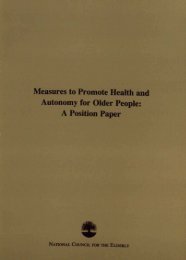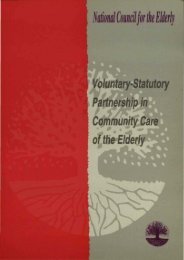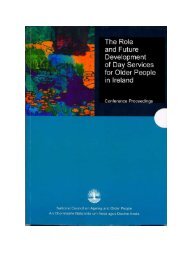From Ageism to Age Equality: Addressing the Challenges ...
From Ageism to Age Equality: Addressing the Challenges ...
From Ageism to Age Equality: Addressing the Challenges ...
Create successful ePaper yourself
Turn your PDF publications into a flip-book with our unique Google optimized e-Paper software.
Table 7: Forms of less favourable treatment of older friends and relatives by financialservices industry reported by respondentsTreatment by financial services industryRefused loan/mortgage/credit 49%Do not get same concessions as o<strong>the</strong>rs/do not get asgood a deal/pay <strong>to</strong>o much 19%Problems getting loans/mortgages/credit 11%Bad attitude of staff 5%Problems getting insurance: refused travel/car/home/life insurance 3%O<strong>the</strong>r 9%Respondents were asked about <strong>the</strong>ir knowledge of and views on legislation relating <strong>to</strong> goods andservices and older people. Fifty one per cent were aware that discrimination in this area is illegal, 27per cent did not know whe<strong>the</strong>r or not it was legal and 17 per cent thought it was not illegal. Sixty sixper cent were in favour of such legislation while 20 per cent were against it.22In summary, <strong>the</strong>re is a widespread perception that older people are treated less favourably becauseof <strong>the</strong>ir age. It is noteworthy that younger people were more likely <strong>to</strong> have such a perception;people aged seventy years and over were less likely <strong>to</strong> be negative in <strong>the</strong>ir responses whe<strong>the</strong>r <strong>the</strong>serelated <strong>to</strong> perceptions or reports of experiences with services. There was a strong view across all agegroups that <strong>the</strong> State does not do enough for older people and that <strong>the</strong>y are treated less favourablyby financial services.Employment and Retirement IssuesEmploymentIn setting full employment as an EU objective, <strong>the</strong> European Council in Lisbon identified <strong>the</strong> raisingof <strong>the</strong> <strong>to</strong>tal employment rate from an average of 61 <strong>to</strong> 70 per cent and <strong>the</strong> female employment ratefrom an average of 51 <strong>to</strong> 60 per cent as a goal for 2010. These targets include a 50 per centemployment rate for those aged 55-64 years by 2010. In comparative terms, Ireland fares relativelywell with an employment rate of 48 per cent for people in <strong>the</strong> 55-64 years group in 2002. But this isheavily unbalanced in gender terms: it comprises a 65 per cent employment rate for men and a 31per cent rate for women. 6 In <strong>the</strong> sample for this study, 30 per cent of male and 55 per cent of6 Russell and Fahey (2004) provide a more disaggregated breakdown: <strong>the</strong> male and female employment rates in 2002 for<strong>the</strong> 55-59 years group were 73 per cent for men and 37 per cent for women; for <strong>the</strong> 60-64 years group <strong>the</strong>y were 54per cent for men and 23 per cent for women; for <strong>the</strong> 65-69 years group <strong>the</strong>y were 24 per cent for men and 6 per centfor women.Conference Proceedings















